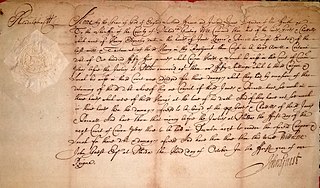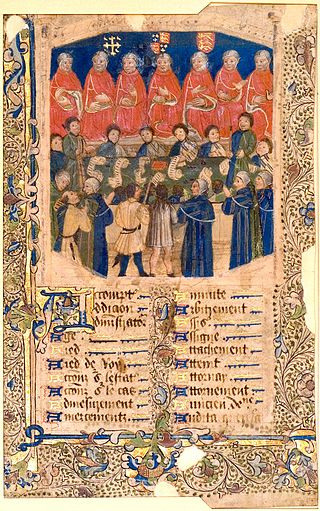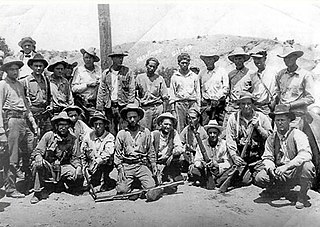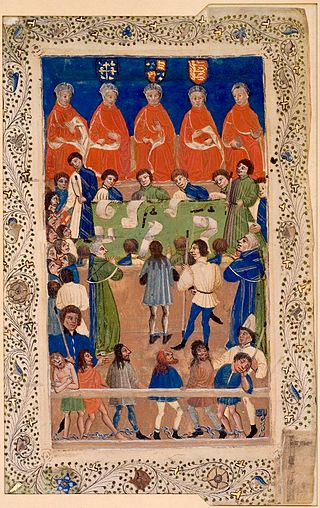Related Research Articles
Contempt of court, often referred to simply as "contempt", is the crime of being disobedient to or disrespectful toward a court of law and its officers in the form of behavior that opposes or defies the authority, justice, and dignity of the court. A similar attitude toward a legislative body is termed contempt of Parliament or contempt of Congress. The verb for "to commit contempt" is contemn and a person guilty of this is a contemnor.
Habeas corpus is a recourse in law through which a person can report an unlawful detention or imprisonment to a court and request that the court order the custodian of the person, usually a prison official, to bring the prisoner to court, to determine whether the detention is lawful.
A sheriff is a government official, with varying duties, existing in some countries with historical ties to England where the office originated. There is an analogous, although independently developed, office in Iceland that is commonly translated to English as sherif.
An arrest warrant is a warrant issued by a judge or magistrate on behalf of the state, which authorizes the arrest and detention of an individual, or the search and seizure of an individual's property.

In common law, a writ is a formal written order issued by a body with administrative or judicial jurisdiction; in modern usage, this body is generally a court. Warrants, prerogative writs, subpoenas, and certiorari are common types of writ, but many forms exist and have existed.
A summons is a legal document issued by a court or by an administrative agency of government for various purposes.
A warrant is generally an order that serves as a specific type of authorization, that is, a writ issued by a competent officer, usually a judge or magistrate, that permits an otherwise illegal act that would violate individual rights and affords the person executing the writ protection from damages if the act is performed.

A bailiff is a manager, overseer or custodian – a legal officer to whom some degree of authority or jurisdiction is given. Bailiffs are of various kinds and their offices and duties vary greatly.
A subpoena or witness summons is a writ issued by a government agency, most often a court, to compel testimony by a witness or production of evidence under a penalty for failure. There are two common types of subpoenas:
- subpoena ad testificandum orders a person to testify before the ordering authority or face punishment. The subpoena can also request the testimony to be given by phone or in person.
- subpoena duces tecum orders a person or organization to bring physical evidence before the ordering authority or face punishment. This is often used for requests to mail copies of documents to requesting party or directly to court.
Marshal is a term used in several official titles in various branches of society. As marshals became trusted members of the courts of Medieval Europe, the title grew in reputation. During the last few centuries, it has been used for elevated offices, such as in military rank and civilian law enforcement.
A high sheriff is a ceremonial officer for each shrieval county of England and Wales and Northern Ireland or the chief sheriff of a number of paid sheriffs in U.S. states who outranks and commands the others in their court-related functions. In Canada, the High Sheriff provides administrative services to the supreme and provincial courts.
A subpoena ad testificandum is a court summons to appear and give oral testimony for use at a hearing or trial. The use of a writ for purposes of compelling testimony originated in the ecclesiastical courts of Church during the High Middle Ages, especially in England. The use of the subpoena writ was gradually adopted over time by civil and criminal courts in England and the European continent.

The Court of Common Pleas, or Common Bench, was a common law court in the English legal system that covered "common pleas"; actions between subject and subject, which did not concern the king. Created in the late 12th to early 13th century after splitting from the Exchequer of Pleas, the Common Pleas served as one of the central English courts for around 600 years. Authorised by Magna Carta to sit in a fixed location, the Common Pleas sat in Westminster Hall for its entire existence, joined by the Exchequer of Pleas and Court of King's Bench.

The Habeas Corpus Act 1640 was an Act of the Parliament of England.
In English law, the assize of novel disseisin was an action to recover lands of which the plaintiff had been disseised, or dispossessed. It was one of the so-called "petty (possessory) assizes" established by Henry II in the wake of the Assize of Clarendon of 1166; and like the other two was only abolished in 1833.

The posse comitatus, frequently shortened to posse, is in common law a group of people mobilized by the conservator of peace – typically a reeve, sheriff, chief, or another special/regional designee like an officer of the peace potentially accompanied by or with the direction of a justice or ajudged parajudicial process given the imminence of actual damage – to suppress lawlessness, defend the people, or otherwise protect the place, property, and public welfare. The posse comitatus as an English jurisprudentially defined doctrine dates back to ninth-century England and the campaigns of Alfred the Great simultaneous thereafter with the officiation of sheriff nomination to keep the regnant peace. Justus Causus is everpresently necessary in establishing, forming, or calling up a posse and can never be the basis for the very lawlessness or subversion of order this legal maxim is intended to subdue and defend against.

The Bill of Middlesex was a legal fiction used by the Court of King's Bench to gain jurisdiction over cases traditionally in the remit of the Court of Common Pleas. Hinging on the King's Bench's remaining criminal jurisdiction over the county of Middlesex, the Bill allowed it to take cases traditionally in the remit of other common law courts by claiming that the defendant had committed trespass in Middlesex. Once the defendant was in custody, the trespass complaint would be quietly dropped and other complaints would be substituted.

The Court of King's Bench, formally known as The Court of the King Before the King Himself, was a court of common law in the English legal system. Created in the late 12th to early 13th century from the curia regis, the King's Bench initially followed the monarch on his travels. The King's Bench finally joined the Court of Common Pleas and Exchequer of Pleas in Westminster Hall in 1318, making its last travels in 1421. The King's Bench was merged into the High Court of Justice by the Supreme Court of Judicature Act 1873, after which point the King's Bench was a division within the High Court. The King's Bench was staffed by one Chief Justice and usually three Puisne Justices.
In the United States, there is no consistent use of the office of constable throughout the states; use may vary within a state. A constable may be an official responsible for service of process: such as summonses and subpoenas for people to appear in court in criminal and/or civil matters. They can also be fully empowered law enforcement officers. Constables may have additional specialized duties unique to the office. In some states the constable is an elected or appointed position at the state or local level of local government. Their jurisdiction can vary from statewide to county/parish and local township boundaries based on the state's laws.
References
- ↑ " [I]t derives its name from a supposition that the defendant lurks and lies hid, and cannot be found in the county of Middlesex (in which the said court is holden) to be taken there, but is gone into some other county, and therefore requiring the sheriff to apprehend him in such other county." Fitz. N. B. 78.